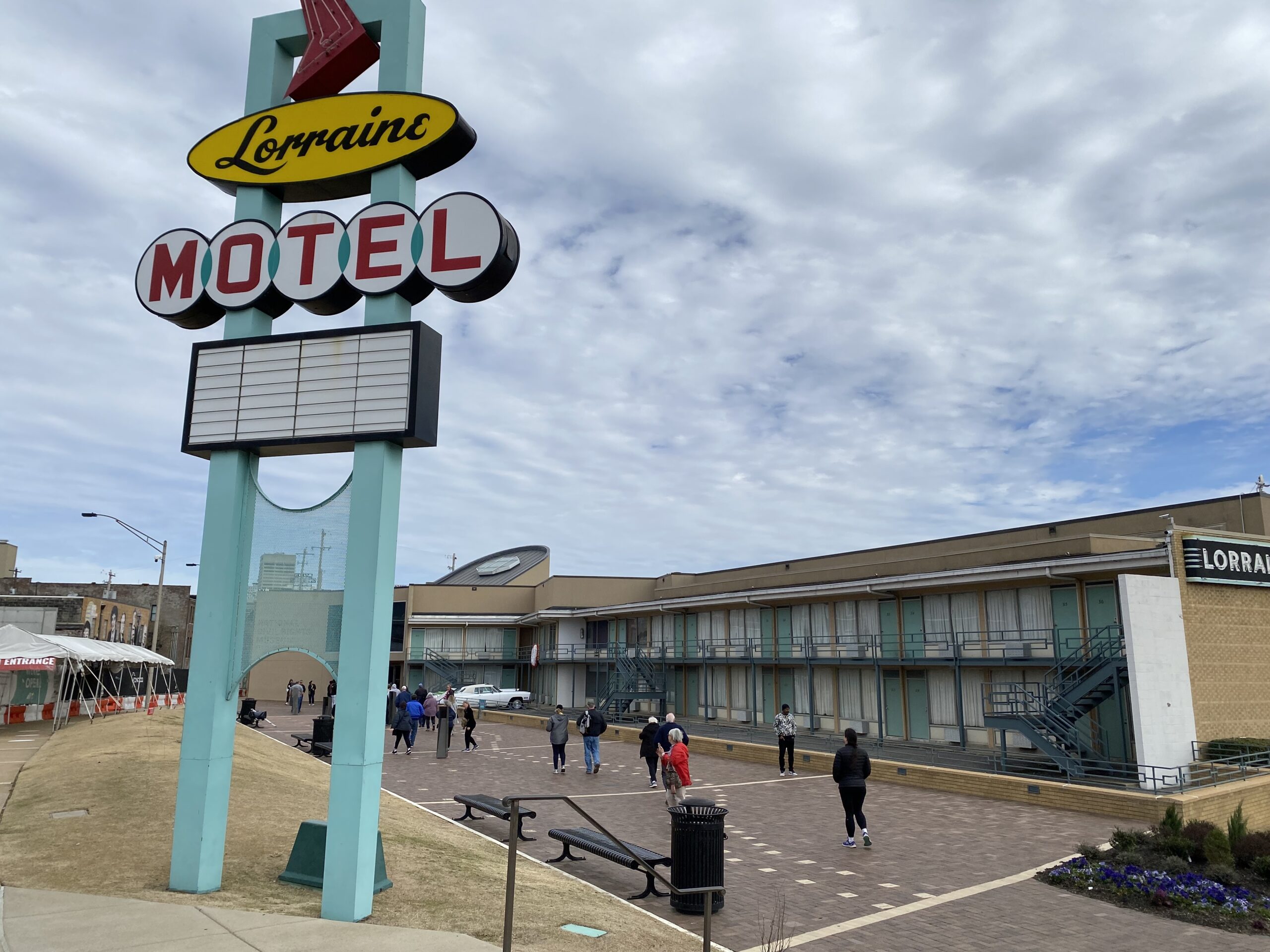Crossing the state of Tennessee, we departed Nashville and drove to Memphis, or technically West Memphis, just across the state border with Arkansas. Our campground, the Tom Sawyer RV Park, sat on the banks of the mighty Mississippi. From our site, we could watch boats pushing barges up and down the river.
Our first stop was the National Civil Rights Museum, built out of the Lorraine Motel where Martin Luther King was shot. The outside of the building is mostly unchanged, looking very much like the motel we had seen in historical pictures, including a large 60s era motel sign in front.
Most of the inside of the motel has been reconstructed to tell the story of the civil rights movement, from the slave trade through to King’s assassination.
It’s honestly one the best museums I’ve ever visited. The displays are a wonderful combination of information and artifacts, describing the struggle for equality in the United States. The timeline picked up many of the threads we had already explored on our strip, the march in Selma, Rosa Parks, the Freedom Riders.

We spent two hours working our way through the museum, which culminates at the room in which King stayed, still unchanged from that fateful day. You can look out the window and see the spot where he was shot and the red brick building from which the shot emanated.
The museum also highlights some of the debate within the Black community about how best to achieve their goals. Some, like Malcolm X, advocated that Blacks should separate rather than integrate from whites, that expecting whites to voluntarily give up their power was something that was never going to happen. Some felt that blacks should concentrate on improving their economic condition first, and then worry about equality later. Others, including King, felt that pressing the issue through nonviolent demonstrations would put pressure on the white establishment to change.
The museum put into context for me many of the individual events of King’s life, including the “I have a dream” speech, the letter from the Birmingham jail and the events that led to his tragic death.
It was also striking to see all of the energy that white southerners put into denying Blacks their civil rights. When Blacks were granted the right to vote, they devised countless ways of keeping Blacks from registering. Whenever a legal ruling went against them, they found another way of achieving their goal. Too much of that still remains today.
We had planned to visit another site that day, Slave Haven, a house that was a part of the underground railroad helping slaves escape to the north. But it was closed after a recent fire.

The next day we headed back to downtown Memphis to the Peabody Hotel where every day, five ducks, under the watchful eye of the Duck Master, ride the elevator down to the lobby and march on a red carpet to the lobby fountain.
The tradition started, as these things often do, with a bottle of liquor. Two hunters who were staying at the hotel had drunken more than their share, and thought it would be funny to take the hotel’s live duck decoys and put them in the fountain.
The next day, the ducks attracted quite a crowd and the hotel manager knew he was on to something. One of the hotel porters had previously worked as an animal trainer in the circus and offered to train the ducks to ride the elevator down from the roof where they lived every morning and march to the fountain. Then at they end of the day, they’d march back.
People started to gather in the lobby an hour before the scheduled march, securing the best vantage points to see the ducks. The duck master, resplendent in a red jacket, holding a duck headed cane, invited the children in the audience to sit alongside the red carpet. Then he rode the elevator to the top to retrieve the ducks.
The excitement was palpable as the numbers above the elevator started to descend. A chime announced their arrival, the doors opened and five ducks — one male and four females — waddled their way through the crowd and to the water.
It was all very silly, but give credit to the hotel, they had a room full of spectators many of them ordering overpriced drinks from the lobby bar. The hotel didn’t pressure anybody into spending any money, and we could observe the entire escapade without it costing us a dime.
Our plan had been to go to Mud Island, a park in the middle of the river that has a three-quarter mile long recreation of the Mississippi River. But after parking the truck, and feeding the parking meter, we discovered the island was closed. We asked an attendant at a parking garage and he told us it had been shut down for months.
We decided to check out the Bass Pro Shops building down by the river. It’s a huge pyramid structure that sits just off the highway leading out of town. We’re not sure of the story behind it, but the building is massive holding the store of mostly hunting and fishing gear, a couple of restaurants and a hotel. Inside, there are tanks and open ponds of fish, plenty of stuffed game animals, and a display with live alligators. It wasn’t something we’d come to Memphis to see, but a spectacle worth a few minutes nonetheless.
Days: 53
Miles Traveled: 7485
Next stop: Vicksburg, Mississippi



How easy or difficult is it to keep track of what day of the week it is?
I generally have no idea without checking my phone.